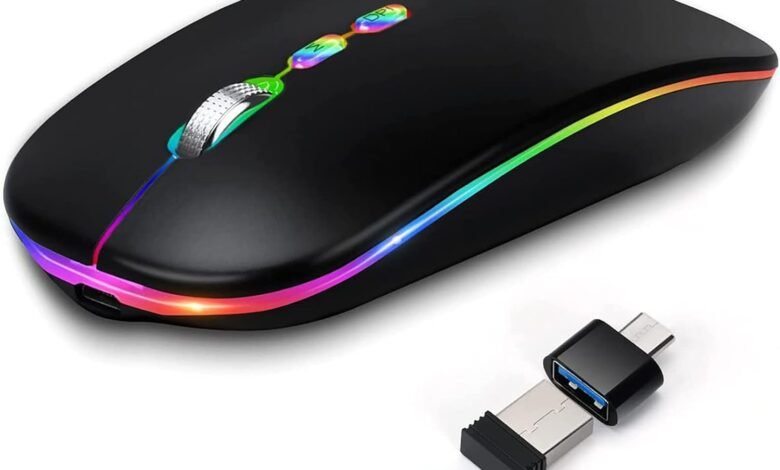Wireless Mouse: The Future of Seamless Computing

Introduction
Wireless Mouse technology has shaped the way we work, play, and interact with devices, and one of the most underrated innovations in this space is the wireless mouse. Once considered a luxury, the wireless mouse has now become a common accessory for laptops, desktops, and even gaming setups. It combines comfort, portability, and advanced features that make computing more efficient. But despite its popularity, many people still wonder whether a wireless mouse is worth the investment, especially compared to its wired counterpart.
In this article, we’ll explore everything you need to know about wireless mice—from their benefits and types to features, pricing, and buying tips. By the end, you’ll understand why the wireless mouse is more than just a convenient gadget—it’s an essential tool for modern users.
What is a Wireless Mouse?
A wireless mouse is a computer accessory that connects to your device without the use of a physical cable. Unlike a traditional wired mouse, it relies on either radio frequency (RF) technology or Bluetooth to establish a connection. Most models come with a small USB dongle, while others connect directly via Bluetooth, eliminating the need for extra hardware.
This innovation removes the clutter of tangled wires on your desk, allowing for greater mobility and convenience. Whether you’re scrolling through spreadsheets, editing videos, or enjoying a gaming session, the wireless mouse offers freedom of movement that wired devices simply can’t match.
What makes it even more appealing is the wide range of designs available today. From minimalist, travel-sized models to high-performance gaming mice packed with features, the wireless mouse has evolved to suit different types of users.
Advantages of Using a Wireless Mouse

1. Freedom of Movement
One of the biggest advantages of a wireless mouse is mobility. Without the restriction of cables, you can use it from a distance, which is particularly useful when connecting your computer to a larger screen or projector. Presentations, for instance, become far smoother when you’re not tied to your desk.
2. Clutter-Free Setup
Wires often create a mess on desks, making setups look untidy. A wireless mouse eliminates this issue, giving your workspace a clean and professional appearance. This is especially important for people who value aesthetics or work in environments where presentation matters.
3. Portability
Wireless mice are typically compact and lightweight, making them easy to carry in a laptop bag. Frequent travelers and remote workers find them especially useful because they don’t have to deal with cords getting tangled during transit.
4. Advanced Features
Many modern wireless mice come with additional features like programmable buttons, adjustable DPI (dots per inch) settings for sensitivity, and ergonomic designs. Some even offer silent clicks, rechargeable batteries, or dual connectivity options (RF and Bluetooth).
Types of Wireless Mouse
1. RF (Radio Frequency) Mouse
These mice use a small USB receiver or dongle to connect to your computer. The dongle usually works instantly without drivers, making it a simple plug-and-play option. RF mice are reliable and generally faster in response compared to Bluetooth models.
2. Bluetooth Mouse
A Bluetooth mouse doesn’t require a separate dongle if your device already supports Bluetooth. It connects directly to your laptop, tablet, or PC, saving you one USB port. However, Bluetooth mice can sometimes face connectivity delays, although modern versions have improved significantly.
3. Rechargeable vs. Battery-Operated
Wireless mice are either rechargeable or powered by replaceable batteries. Rechargeable models are eco-friendly and cost-effective in the long run, while battery-operated ones offer longer usage times before replacement but can be inconvenient if the battery dies unexpectedly.
Wireless Mouse for Different Users
1. Office Professionals
For professionals who spend hours working on documents, spreadsheets, and emails, a wireless mouse provides comfort and flexibility. Ergonomic designs reduce wrist strain, while silent clicks prevent distractions in quiet office environments.
2. Gamers
Gaming mice have become a separate category, with wireless models offering ultra-fast response times and customizable features. Brands like Logitech, Razer, and SteelSeries produce gaming-grade wireless mice that rival wired ones in speed and precision.
3. Students and Casual Users
For everyday use like browsing, streaming, or studying, a budget-friendly wireless mouse is more than enough. Students often prefer portable models that they can easily use with laptops during lectures or study sessions.
4. Creatives and Designers
Graphic designers, video editors, and other creatives require precision. High-end wireless mice offer customizable DPI settings, programmable buttons, and smooth tracking, making them indispensable for creative work.
Common Concerns with Wireless Mouse
1. Battery Life
A common complaint about wireless mice is the need to recharge or replace batteries. While modern models often boast weeks or even months of usage, it’s still something users need to monitor.
2. Lag and Connectivity Issues
Older wireless mice had noticeable input lag, which made them less suitable for gaming or precision tasks. However, newer technologies have almost eliminated this issue, making wireless mice nearly as responsive as wired ones.
3. Price Factor
Wireless mice tend to be more expensive than wired models. For budget-conscious buyers, this can be a drawback. However, the added convenience, portability, and features often justify the price difference.
How to Choose the Best Wireless Mouse
1. Consider Your Usage
Ask yourself—what do you need the mouse for? If you’re a gamer, look for models with adjustable DPI and extra buttons. For office use, prioritize ergonomics and silent operation.
2. Check Battery Options
Decide whether you prefer rechargeable models or those with replaceable batteries. Rechargeable ones are eco-friendly, but if you often forget to charge devices, battery-operated might suit you better.
3. Size and Comfort
The size and shape of a mouse can make a huge difference. Test different models if possible and see which one feels most natural in your hand. Comfort is key, especially if you spend hours using it.
4. Connectivity Options
If you want flexibility, choose a dual-mode wireless mouse that supports both RF and Bluetooth. This way, you’ll never be stuck if you lose the dongle or need to connect to a different device.
Popular Wireless Mouse Brands in 2025
- Logitech – Known for a wide range of models catering to casual users, gamers, and professionals.
- Razer – A favorite among gamers for high-performance and stylish designs.
- HP & Dell – Reliable, budget-friendly options for office and student use.
- Apple – Sleek and stylish Magic Mouse designed exclusively for Mac users.
- Microsoft – Offers ergonomic and productivity-focused wireless mice.
Final Thoughts
The wireless mouse is no longer just a fancy accessory—it’s a practical and essential tool for modern computing. Whether you’re working in an office, gaming at home, or studying on the go, a wireless mouse offers freedom, comfort, and features that wired models can’t always provide.
Of course, like any device, it has its drawbacks—battery management, cost, and occasional connectivity issues. But when you balance the pros and cons, the convenience and performance make it a smart investment.
If you’re still using a wired mouse in 2025, it might be the right time to upgrade. A wireless mouse won’t just declutter your desk—it will redefine the way you work and interact with your devices.



